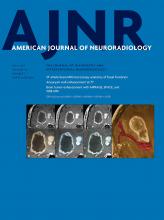Index by author
Cagnazzo, F.
- NeurointerventionYou have accessAntiplatelet Therapy in Patients with Aneurysmal SAH: Impact on Delayed Cerebral Ischemia and Clinical Outcome. A Meta-AnalysisF. Cagnazzo, I. Derraz, P.-H. Lefevre, G. Gascou, C. Dargazanli, C. Riquelme, P. Perrini, D. di Carlo, A. Bonafe and V. CostalatAmerican Journal of Neuroradiology July 2019, 40 (7) 1201-1206; DOI: https://doi.org/10.3174/ajnr.A6086
Cankurtaran, C.Z.
- FunctionalOpen AccessA Practical Review of Functional MRI Anatomy of the Language and Motor SystemsV.B. Hill, C.Z. Cankurtaran, B.P. Liu, T.A. Hijaz, M. Naidich, A.J. Nemeth, J. Gastala, C. Krumpelman, E.N. McComb and A.W. KorutzAmerican Journal of Neuroradiology July 2019, 40 (7) 1084-1090; DOI: https://doi.org/10.3174/ajnr.A6089
Charbonneau, F.
- FELLOWS' JOURNAL CLUBAdult BrainYou have accessDiagnosis and Prediction of Relapses in Susac Syndrome: A New Use for MR Postcontrast FLAIR Leptomeningeal EnhancementS. Coulette, A. Lecler, E. Saragoussi, K. Zuber, J. Savatovsky, R. Deschamps, O. Gout, C. Sabben, J. Aboab, A. Affortit, F. Charbonneau and M. ObadiaAmerican Journal of Neuroradiology July 2019, 40 (7) 1184-1190; DOI: https://doi.org/10.3174/ajnr.A6103
From January 2011 to December 2017, nine consecutive patients with Susac syndrome and a control group of 73 patients with multiple sclerosis or clinically isolated syndrome were included. Two neuroradiologists blinded to the clinical and ophthalmologic data independently reviewed MRIs and assessed leptomeningeal enhancement and parenchymal abnormalities. Follow-up MRIs of patients with Susac syndrome were reviewed and compared with clinical and retinal fluorescein angiographic data evaluated by an independent ophthalmologist. Patients with Susac syndrome were significantly more likely to present with leptomeningeal enhancement: 5/9 (56%) versus 6/73 (8%) in the control group. They had a significantly higher leptomeningeal enhancement burden with ≥3 lesions in 5/9 patients versus 0/73. Regions of leptomeningeal enhancement were significantly more likely to be located in the posterior fossa. The authors conclude that leptomeningeal enhancement occurs frequently in Susac syndrome and could be helpful for diagnosis and prediction of clinical relapse.
Chen, B.
- Adult BrainYou have accessWall Contrast Enhancement of Thrombosed Intracranial Aneurysms at 7T MRIT. Sato, T. Matsushige, B. Chen, O. Gembruch, P. Dammann, R. Jabbarli, M. Forsting, A. Junker, S. Maderwald, H.H. Quick, M.E. Ladd, U. Sure and K.H. WredeAmerican Journal of Neuroradiology July 2019, 40 (7) 1106-1111; DOI: https://doi.org/10.3174/ajnr.A6084
Chopra, A.M.
- LetterYou have accessPolymer Embolism from Bioactive and Hydrogel Coil Embolization Technology: Considerations for Product DevelopmentA.M. Chopra, J.P. Cruz and Y.C. HuAmerican Journal of Neuroradiology July 2019, 40 (7) E34-E35; DOI: https://doi.org/10.3174/ajnr.A6083
Cianfoni, A.
- EDITOR'S CHOICEAdult BrainYou have accessBrain Tumor-Enhancement Visualization and Morphometric Assessment: A Comparison of MPRAGE, SPACE, and VIBE MRI TechniquesL. Danieli, G.C. Riccitelli, D. Distefano, E. Prodi, E. Ventura, A. Cianfoni, A. Kaelin-Lang, M. Reinert and E. PravatàAmerican Journal of Neuroradiology July 2019, 40 (7) 1140-1148; DOI: https://doi.org/10.3174/ajnr.A6096
Fifty-four contrast-enhancing tumors (38 gliomas and 16 metastases) were assessed using MPRAGE, VIBE, and SPACE techniques randomly acquired after gadolinium-based contrast agent administration on a 3T scanner. Enhancement conspicuity was assessed quantitatively by calculating the contrast rate and contrast-to-noise ratio, and qualitatively, by consensus visual comparative ratings. Compared with MPRAGE, both SPACE and VIBE obtained higher contrast rate, contrast-to-noise ratio, and visual conspicuity ratings in both gliomas and metastases. The authors conclude that superior conspicuity for brain tumor enhancement can be achieved using SPACE and VIBE techniques, compared with MPRAGE.
Clayton, D.B.
- SpineYou have accessQuantification of DTI in the Pediatric Spinal Cord: Application to Clinical Evaluation in a Healthy Patient PopulationB.B. Reynolds, S. By, Q.R. Weinberg, A.A. Witt, A.T. Newton, H.R. Feiler, B. Ramkorun, D.B. Clayton, P. Couture, J.E. Martus, M. Adams, J.C. Wellons, S.A. Smith and A. BhatiaAmerican Journal of Neuroradiology July 2019, 40 (7) 1236-1241; DOI: https://doi.org/10.3174/ajnr.A6104
Coenen, W.
- SpineYou have accessSubject-Specific Studies of CSF Bulk Flow Patterns in the Spinal Canal: Implications for the Dispersion of Solute Particles in Intrathecal Drug DeliveryW. Coenen, C. Gutiérrez-Montes, S. Sincomb, E. Criado-Hidalgo, K. Wei, K. King, V. Haughton, C. Martínez-Bazán, A.L. Sánchez and J. C. LasherasAmerican Journal of Neuroradiology July 2019, 40 (7) 1242-1249; DOI: https://doi.org/10.3174/ajnr.A6097
Collins, D.L.
- EDITOR'S CHOICEAdult BrainOpen AccessComparison of Multiple Sclerosis Cortical Lesion Types Detected by Multicontrast 3T and 7T MRIJ. Maranzano, M. Dadar, D.A. Rudko, D. De Nigris, C. Elliott, J.S. Gati, S.A. Morrow, R.S. Menon, D.L. Collins, D.L. Arnold and S. NarayananAmerican Journal of Neuroradiology July 2019, 40 (7) 1162-1169; DOI: https://doi.org/10.3174/ajnr.A6099
The aim of the authors was: 1) to compare multicontrast cortical lesion detection using 3T and 7T MR imaging, 2) to compare cortical lesion type frequency in relapsing-remitting and secondary-progressive MS, and 3) to assess whether detectability is related to the magnetization transfer ratio, an imaging marker sensitive to myelin content. Multicontrast 3T and 7T MR images from 10 patients with relapsing-remitting MS and 10 with secondary-progressive MS were evaluated with the following 3T contrasts: 3D-T1-weighted, quantitative T1, FLAIR and magnetization-transfer, and 2D proton density- and T2-weighted. The following 7T contrasts were used: 3D-T1-weighted, quantitative T1, and 2D-T2*-weighted. Cortical lesion counts at 7T were the following: 720 total cortical lesions, 420 leukocortical lesions (58%), 27 intracortical lesions (4%), and 273 subpial lesions (38%). Cortical lesion counts at 3T were the following: 424 total cortical, 393 leukocortical (93%), 0intracortical, and 31 subpial (7%) lesions. Total, intracortical, and subpial 3T lesion counts were significantly lower than the 7Tcounts. The authors conclude that detection of leukocortical lesions at 3T is comparable with that at 7T MR imaging. Imaging at 3T is less sensitive to intracortical and subpial lesions.
Costalat, V.
- NeurointerventionYou have accessAntiplatelet Therapy in Patients with Aneurysmal SAH: Impact on Delayed Cerebral Ischemia and Clinical Outcome. A Meta-AnalysisF. Cagnazzo, I. Derraz, P.-H. Lefevre, G. Gascou, C. Dargazanli, C. Riquelme, P. Perrini, D. di Carlo, A. Bonafe and V. CostalatAmerican Journal of Neuroradiology July 2019, 40 (7) 1201-1206; DOI: https://doi.org/10.3174/ajnr.A6086








